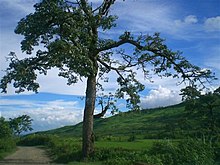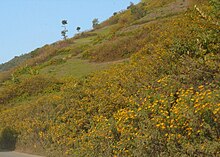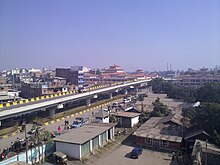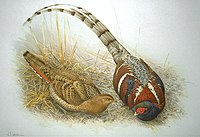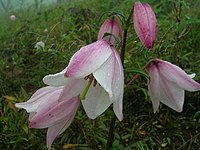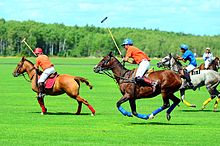Manipur
| Manipur | ||
|---|---|---|
| State | ||

Lohtak Lake, around 30 km from the capitalImphal
| ||
| ||
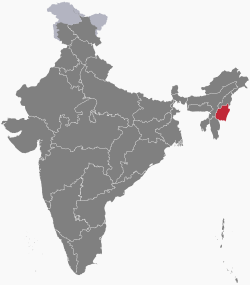 | ||
| Country | ||
| Formation | 21 January 1972† | |
| Capital | Imphal | |
| Districts | 16 | |
| Government | ||
| • Governor | Najma Heptulla[1] | |
| • Chief Minister | N. Biren Singh(BJP)[2] | |
| • Legislature | Unicameral (60 seats) | |
| • Parliamentary constituency | Rajya Sabha 1 Lok Sabha 2 | |
| • High Court | Manipur High Court | |
| Area | ||
| • Total | 22,327 km2(8,621 sq mi) | |
| Area rank | 24th | |
| Population (2011[3]) | ||
| • Total | 2,855,794 | |
| • Rank | 24th | |
| • Density | 130/km2 (330/sq mi) | |
| Time zone | IST (UTC+05:30) | |
| ISO 3166 code | IN-MN | |
| HDI | ||
| HDI rank | 5th (2005) | |
| Literacy | 79.85% (16th) | |
| Official languages | Meitei (Manipuri)[4][5] | |
| Website | www.manipur.gov.in | |
| † It elevated from the status of Union-Territories by the North-Eastern Areas (Reorganisation) Act 1971 | ||
| Language | Meitei |
|---|---|
| Animal | Sangai-Rucervus eldii eldii |
| Bird | Nongyeen-Syrmaticus humiae |
| Flower | Siroi lily-Lilium mackliniae |
| Tree | Uningthou-Phoebe hainesiana |
Manipur (/ˈmʌnɪpʊr/ ( listen)) is a state in Northeast India, with the city of Imphal as its capital.[6] It is bounded by Nagaland to the north, Mizoram to the south, and Assam to the west; Burma (Myanmar) lies to its east. The state covers an area of 22,327 square kilometres (8,621 sq mi) and has a population of almost 3 million, including the Meitei, who are the majority group in the state, Kukiand Naga peoples, who speak a variety of Sino-Tibetan languages. Manipur has been at the crossroads of Asian economic and cultural exchange for more than 2,500 years.[7] It has long connected the Indian subcontinent to Southeast Asia, enabling migration of people, cultures and religions.[8]
listen)) is a state in Northeast India, with the city of Imphal as its capital.[6] It is bounded by Nagaland to the north, Mizoram to the south, and Assam to the west; Burma (Myanmar) lies to its east. The state covers an area of 22,327 square kilometres (8,621 sq mi) and has a population of almost 3 million, including the Meitei, who are the majority group in the state, Kukiand Naga peoples, who speak a variety of Sino-Tibetan languages. Manipur has been at the crossroads of Asian economic and cultural exchange for more than 2,500 years.[7] It has long connected the Indian subcontinent to Southeast Asia, enabling migration of people, cultures and religions.[8]
During the Raj, the Kingdom of Manipur was one of the princely states.[9] Between 1917 and 1939, the people of Manipur pressed for their rights against British rule. By the late 1930s, the princely state of Manipur negotiated with the British administration its preference to be part of India, rather than Burma. These negotiations were cut short with the outbreak of World War II. On 21 September 1949, Maharaja Budhachandra signed a Treaty of Accession merging the kingdom into India.[10] This merger has been disputed by groups in Manipur as having been completed without consensus and under duress.[11] The dispute and differing visions for the future has resulted in a 50-year insurgency in the state for independence from India, as well as in repeated episodes of violence among ethnic groups in the state.[12] From 2010 through 2013, the militant insurgency was responsible for the violent death of about 1 civilian per 100,000 people, each year.[13] The world average annual death rate from intentional violence has been 7.9 per 100,000 people.[14]
The Meitei ethnic group,[15] represents 53% of the population of Manipur state. The main language of the state is Meitei (also known as Manipuri). Tribes constituting about 20% of the state population are distinguished by dialects and cultures that are often village-based. Manipur's ethnic groups practice a variety of religions.[16] According to 2011 census, Hinduism is the major religion in the state, closely followed by Christianity. Other religions include Islam, Sanamahism, Buddhism etc.[16][17]
Manipur has primarily an agrarian economy, with significant hydroelectric power generation potential. It is connected to other areas by daily flights through Imphal airport, the second largest in northeastern India.[18] Manipur is home to many sports, the origin ofManipuri dance,[19] and is credited with introducing polo to Europeans.[20]
Contents
[hide]Alternate names[edit]
Manipur is mentioned in historic texts as Kangleipak or Meeteileipak[21] Sanamahi Laikan wrote that officials during the reign of Meidingu Pamheiba in the eighteenth century adopted Manipur's new name.
According to Sakok Lamlen, the area had different names in its history. During the Hayachak period, it was known as Mayai Koiren poirei namthak saronpung or Tilli Koktong Ahanba; in the Khunungchak period, it was Meera Pongthoklam. During the Langbachak era, it became Tilli Koktong Leikoiren, and finally was known as Muwapali in theKonnachak epoch.[22][page needed]
Neighbouring cultures each had differing names for Manipur and its people. The Shan or Pong called the area Cassay, the Burmese Kathe, and the Assamese Meklee. In the first treaty between the British East India Company and Meidingu Chingthangkhomba (Bhagyachandra) signed in 1762, the kingdom was recorded as Meckley. Bhagyachandra and his successors issued coins engraved with "Manipureshwar", or "lord of Manipur", and the British discarded the name Meckley. Later on, the work Dharani Samhita (1825–34) popularised the Sanskrit legends of the origin of Manipur's name.[23]
The term Kanglei, meaning "of Manipur/Kangleipak", is used to refer to items associated with the state where the term Manipuri is a recent given name.
| Examples using the term "Kanglei" | Translation |
|---|---|
| Kanglei | of Kangleipak/Manipur |
| Kangleicha | People of Kangleipak/Manipur |
| Kanglei foods | Foods of Kangleipak/Manipur |
| Kanglei style | Style of Kangleipak/Manipur |
History[edit]
The history of Manipur Meities is chronicled in Puyas or Puwaris (stories about our forefathers), namely, the Ninghthou Kangbalon, Cheitharol Kumbaba, Ningthourol Lambuba, Poireiton Khunthokpa, Panthoibi Khongkul, etc. in the archaic Meitei script, which is comparable to the Thai script. The historical accounts presented here were recordings from the eyes and the judgment of the Meitei Kings and Maichous (Meitei scholars). Hill tribes have their own folk tales, myths and legends. Manipur was known by different names at various periods in its history, such as, Tilli-Koktong, Poirei-Lam, Sanna-Leipak, Mitei-Leipak, Meitrabak or Manipur (present day). Its capital was Kangla, Yumphal or Imphal (present day). Its people were known by various names, such as Mi-tei, Poirei-Mitei, Meetei, Maitei or Meitei. The Puwaris, Ninghthou Kangbalon, Ningthourol Lambuba, Cheitharol Kumbaba, Poireiton Khunthokpa, recorded the events of each King who ruled Manipur in a span of more than 3500 years until 1955 AD (a total of more than 108 kings). Ningthou Kangba (15th century BC) is regarded the first and foremost king of Manipur. There were times when the country was in turmoil without rulers and long historical gaps in between 1129 BC - 44 BC. In 1891 AD, after the defeat of the Meiteis by the British in the Anglo-Manipuri war of Khongjom, Manipur’s sovereignty for more than three millenniums was lost. It regained its freedom on August 28, 1947 AD but did not last long. On 15 October 1949, Manipur was annexed into the Indian territory.[24]
Medieval[edit]
By the medieval period, marriage alliances between royal families of the Manipuri kingdom, Ahom (Assam) and Burma had become common.[24] Medieval era Manipuri manuscripts discovered in the 20th century, particularly the Puya, provide evidence that Hindus from the Indian subcontinent were married to Manipur royalty at least by the 14th century. In centuries thereafter, royal spouses came also from what is now modern Assam, Bengal, Uttar Pradesh along with ancient Dravidian kingdoms, and other regions.[25] Another manuscript suggests that Muslims arrived in Manipur in the 17th century, from what is now Bangladesh, during the reign of Meidingu Khagemba.[25] The socio-political turmoil and wars, particularly the persistent and devastating Manipur-Burma wars, affected the cultural and religious demography of Manipur.[26]
Colonial period[edit]
In the late 19th century, the British Empire in the Indian subcontinent annexed Manipur, with its status maintained as a princely state.[27] DuringWorld War II, Manipur was the scene of many fierce battles between Japanese invaders and British Indian forces. The Japanese were beaten back before they could enter Imphal, which was one of the turning points of the overall war.
Modern history[edit]
After the war, the princely states and India moved toward independence. The Manipur Constitution Act of 1947 established a democratic form of government, with the Maharaja as the executive head. Faced with Burma's ambitions to take over the state, in 1949, Maharaja Bodhchandrawent to Shillong, where he signed the instrument of accession to merge the kingdom into India instead. Thereafter the legislative assembly was dissolved, and Manipur became part of the Republic of India in October 1949.[28] It was made a Union Territory in 1956.[29] and a fully-fledged State in 1972.[30]
Other ethnic groups opposed the merger with India. A separatist movement has been active in Manipur since 1964, when United National Liberation Front was founded. Several groups have used violence toward achieving their goal of a sovereign Manipur. In addition, tribal peoples have demanded division of the present state into two or three Indian states along ethnic lines. Due to the state's continuing political conflicts and isolated geography. the national government has defined it as one of India's "sensitive areas".
Manipur has had a long record of insurgency and inter-ethnic violence.[31][32] The first armed opposition group in Manipur, the United National Liberation Front (UNLF), was founded in 1964, which declared that it wanted to gain independence from India and form Manipur as a new country. Over time, many more groups formed in Manipur, each with different goals, and deriving support from diverse ethnic groups in Manipur. For example, in 1977 the People's Revolutionary Party of Kangleipak (PREPAK) was formed, the People's Liberation Army (PLA) was formed in 1978 which Human Rights Watch states as having received arms and training from China. In 1980, theKangleipak Communist Party (KCP) was formed. These groups began a spree of bank robberies and attacks on police officers and government buildings. The state government appealed to the central government in New Delhi for support in combating this violence.[12]
From 1980–2004, the Indian government referred to Manipur as a so-called disturbed area. This term (designated by the Ministry of Home Affairs or a state governor) refers to a territory (historically: Manipur, Assam, Nagaland, etc.) where extraordinary laws under the Armed Forces (Special Powers) Act can be used. The laws allow the military to treat private and public spaces in the same manner, detain individuals up to 24 hours with unlimited renewals, to perform warrantless searches, and to shoot and kill individuals that break laws, carry weapons, or gather in groups larger than four as well as giving legal immunity to the military.[33]
Since 1980, the application of AFSPA has been at the heart of concerns about human rights violations in the region, such as arbitrary killings, torture, cruel, inhuman and degrading treatment, and forced disappearances. Its continued application has led to numerous protests, notably the longstanding hunger strike by Irom Sharmila Chanu.[citation needed]
In 2004, the government lifted the disturbed status after a violent attack on a local woman. The rape of Thangjam Manorama Devi (a Manipur woman) by members of the Assam Rifles paramilitary had led to wide protests including a nude protest by the Meira Paibis women association. Despite the change in status, the Indian military has a base of administration in Manipur and occupies the state.[34]
Geography[edit]
The state lies at a latitude of 23°83'N – 25°68'N and a longitude of 93°03'E – 94°78'E. The total area covered by the state is 22,347 square kilometres (8,628 sq mi). The capital lies in an oval-shaped valley of approximately 700 square miles (2,000 km2) surrounded by blue mountains and is at an elevation of 790 metres (2,590 ft) above sea level.[35] The slope of the valley is from north to south. The mountain ranges create a moderated climate, preventing the cold winds from the north from reaching the valley and barring cyclonic storms originating from the Bay of Bengal.[citation needed]
The state is bordered by the Indian states of Nagaland to its north, Mizoram to its south, Assam to its west, and shares international border with Myanmar to its east.
The state has four major river basins: the Barak River Basin (Barak Valley) to the west, theManipur River Basin in central Manipur, the Yu River Basin in the east, and a portion of the Lanye River Basin in the north.[36] The water resources of Barak and Manipur river basins are about 1.8487 Mham. The overall water balance of the state amounts to 0.7236 Mham in the annual water budget.[37] (By comparison, India receives 400 Mham (million hectare meters) of rain annually.[38])
The Barak River, the largest of Manipur, originates in the Manipur Hills and is joined by tributaries, such as the Irang, Maku, and Tuivai. After its junction with the Tuivai, the Barak River turns north, forms the border with Assam State, and then enters the Cachar Assam just above Lakhipur. The Manipur river basin has eight major rivers: the Manipur, Imphal, Iril, Nambul, Sekmai, Chakpi, Thoubal and Khuga. All these rivers originate from the surrounding hills.[citation needed]
Almost all the rivers in the valley area are in the mature stage and therefore deposit their sediment load in the Loktak lake.[35] The rivers draining the Manipur Hills are comparatively young, due to the hilly terrain through which they flow. These rivers are corrosive and assume turbulent form in the rainy season. Important rivers draining the western area include the Maku, Barak, Jiri, Irang and Leimatak. Rivers draining the eastern part of the state, the Yu River Basin, include the Chamu, Khunou and other short streams.[citation needed]
Manipur may be characterised as two distinct physical regions: an outlying area of rugged hills and narrow valleys, and the inner area of flat plain, with all associated land forms. These two areas are distinct in physical features and are conspicuous in flora and fauna. The valley region has hills and mounds rising above the flat surface. The Loktak lake is an important feature of the central plain. The total area occupied by all the lakes is about 600 km2. The altitude ranges from 40 m at Jiribam to 2,994 m at Mt. Iso(Tempü) Peak near Mao Songsong.
The soil cover can be divided into two broad types, viz. the red ferruginous soil in the hill area and the alluvium in the valley. The valley soils generally contain loam, small rock fragments, sand and sandy clay, and are varied. On the plains, especially flood plains and deltas, the soil is quite thick. The top soil on the steep slopes is very thin. Soil on the steep hill slopes is subject to high erosion, resulting in gullies and barren rock slopes. The normal pH value ranges from 5.4 to 6.8.[39]
Flora[edit]
Natural vegetation occupies an area of about 14,365 square kilometres (5,546 sq mi), nearly 64% of the total geographical area of the state,[citation needed] and consists of short and tall grasses, reeds and bamboos, and trees. Broadly, there are four types of forests: Tropical Semi-evergreen, Dry Temperate Forest, Sub-Tropical Pine, and Tropical Moist Deciduous.[citation needed]
There are forests of teak, pine, oak, uningthou, leihao, bamboo, and cane. Rubber, tea, coffee, orange, and cardamom are grown in hill areas. Rice, a staple food for Manipuris, and other cash crops make up the main vegetation cover in the valley.[citation needed]
Climate[edit]
The climate of Manipur is largely influenced by the topography of this hilly region. Lying 790 meters above sea level, Manipur is wedged among hills on all sides. This northeastern corner of India enjoys a generally amiable climate, though the winters can be a chilly. The maximum temperature in the summer months is 32 °C (90 °F). In winter the temperature often falls below 0 °C (32 °F), bringing frost. Snow sometimes falls in hilly regions due to the Western Disturbance.[citation needed] The coldest month is January, and the warmest July .
The state is drenched in rains from May until mid-October. It receives an average annual rainfall of 1,467.5 millimetres (57.78 in). Rain distribution varies from 933 millimetres (36.7 in) in Imphal to 2,593 millimetres (102.1 in) in Tamenglong. The precipitation ranges from light drizzle to heavy downpour. The normal rainfall of Manipur enriches the soil and helps in agriculture and irrigation. The South WesterlyMonsoon picks up moisture from the Bay of Bengal and heads toward Manipur, hits the eastern Himalaya ranges and produces a massive amount of rain. The climate is salubrious with approximate average annual rainfall varying from 933 millimetres (36.7 in) at Imphal to 2,593 millimetres (102.1 in) at Tamenglong. The temperature ranges from sub0 to 36 °C (32 to 97 °F).[citation needed]
Demographics[edit]
Population[edit]
| [show]Population Growth |
|---|
Manipur has a population of 2,855,794 as per 2011 census.[40] Of this total, 58.9% live in the valley and the remaining 41.1% in the hilly regions. The hills are inhabited mainly by the Kuki, and Naga, and Smaller tribal communities and the valley(plains) mainly by the Meiteis, Manipuri Brahmins (Bamons) and Pangal (Manipuri Muslims). Bishnupriya Manipuri, Naga and Kuki settlements are also found in the valley region, though less in numbers.
The distribution of area, population and density, and literacy rate as per the 2001 Census provisional figures are as below:[citation needed]
| [hide]Demographics of Manipur (2011) | |
|---|---|
| Total Population | 2,855,794 |
| Male Population | 1,438,586 |
| Female Population | 1,417,208 |
| Rural Population | 1,736,236 |
| Urban Population | 834,154 |
| Child Sex Ratio | 936 female to 1000 male |
| Density (per km2) | 115 |
| Literacy | 1,768,181 (85.4%) |
| Towns | 33 |
People[edit]
The Meitei[15] (synonymous to Manipuri) constitute the majority of the state's population. According to 1891 census Meitei were recorded as a forest tribe. In 1901, the Meitei were recorded as the main ethnicity of Manipur.[41] They live primarily in the state's valley region.[citation needed]. The Meitei are not recognized as a scheduled tribe in the Indian constitution.
Kukis and Nagas are the major tribe conglomerates. The Nagas in Manipur are further sub-divided into sub-tribes: Tangkhul,Maram, Poumai, Angami, Chakhesang, Liangmai, Rongmei, Zeme, and Mao.[42]
Languages[edit]
The official languages are Meitei language and English.
The term Meitei includes Sanamahis, Christians, Hindus and Manipuri Brahmins (locally called "Meetei Bamons"). The Meitei language (or Manipuri) is the lingua franca in Manipur and is one of the languages listed in the Eighth Schedpule of the Indian Constitution. Manipur has a diverse group of ethnic groups speaking different languages and dialects, practising Hinduism, Christianity, Sanamahism, Buddhism, Islam and other folk religions.[16]
The languages spoken in Manipur(2001 census) are Meitei (1,266,098), Poula language(Poumai Naga)[46] (179,189), Thadou-Kuki(1,91,596), Tangkhul (139,979), Kabui (87,950), Paite (48,379), Hmar (43,137), Vaiphei (37,553), Liangmai (32,787), Bengali (27,100), Hindi (24,720), Maring (22,154), Anal (22,187), Zou (20,626), Kom (14,558), Gangte (13,752), Simte (10,028), and Mon(Monsang+Moyon) (7,000).
There are 29 dialects spoken in Manipur.[citation needed]
Religion[edit]
Hinduism[edit]
About 41.39% of Manipuri people are Hindus. Hinduism is mostly professed by Meitei people, who are majority in the state. However, a large minority of Meitei people practices Sanamahism (traditional Meitei religion) and Christianity. Vaishnavism school of Hinduism became a dominant force in Manipur in the eighteenth century when the king, Garib Niwas (1708–48), declared it as the official State religion. This was the Vaishnavism of Chaitanya Mahaprabhu, the Bhakti preacher of Bengal, which stressed Krishna Bhakti. The Hindu population is heavily concentrated in the Manipur valley among the Meitei people. The districts of Bishnupur, Thoubal, Imphal East and Imphal West are all Hindu majorities averaging 67.62% (range 62.27–74.81%) according to the 2011 census data.[47]
Christianity[edit]
Christianity is the religion of 41.29% of the people in the state. It was brought by missionaries to Manipur in the 19th century. In the 20th century, a few Christian schools were established, which introduced Western-type education. Respected schools in Manipur are Little Flower School in Imphal, Don Bosco High School in Imphal, St. Joseph's Convent, and Nirmalabas High School, which are all run by Catholic priests and nuns. The overwhelming majority of the population in the Hill districts are Christian.[47]
Meiteism and Sanamahi[edit]
Folk religions are practised by about 8% of the state's people. These religions have a long history in Manipur. Sanamahism is the ancient indigenous animistic religion.[48] Sanamahi worship is concentrated around the Sun God/Sanamahi. The early Manipuri worshiped a Supreme deity, Lainingthou Soralel, and followed their ancestors. Their ancestor worship and animism was based on Umang Lai – ethnic governing deities worshiped in sacred groves. Some of the traditional deities (Lais) whom Manipuri worship are Atiya Sidaba, Pakhangba, Sanamahi, Leimaren, Oknarel,Thangnarel, Panganba, Thangjing, Marjing, Wangbaren, and Koubru.
According to the 2011 population census the "Other religions and persuasions" category, which included minor Indian religions (other than Hinduism, Islam, Christianity, Sikhism, Buddhism and Jainism), accounted for 8.19% of the population. Like the Hindu population they are concentrated in the Manipur valley districts, where the Meitei people are dominant and account for 14% of the valley population (range 10–16% of the population).[47]
Islam[edit]
Manipuri Muslims, known locally as Meitei Pangal, constitute about 8.3% of the state population as per 2011 census. Sufi saint, Shaikh Shah Jalal d-Dīn al-Mujarrad al-Turk al Naqshbandi, came toSylhet,[citation needed] and Hazrat Azan Fakir Baghdadi arrived in 1690 AD in Assam.[citation needed]They influenced Manipuri Muslims. They belong to the Sunni group of Hanafi school of thought and there are Arab, Bangladesh, Turani, Bengali and Mughal or Chaghtai Turk sections among Manipuri Muslims.[49]
The literacy rate among Muslims is 58.6 percent (male 75 percent and female 41.6 percent) below the state's average of 70.5 percent (male 80.3 percent and female 60.5 percent). In 1995, out of 135,000 Muslims, 5,704 had matriculated from secondary school. There was a total of 1,822 who had graduated in addition to 86 technical and professional graduates. There were 51 Class I Muslim officers including three women, 101 Class II officers and 1,270 and 1,663 employees belonging to Class III and IV categories respectively.[50]
Government[edit]
The government of Manipur is a collective assembly of 60 elected members. Of which 20 are reserved for Scheduled Tribes and 1 for Scheduled Castes. The state sends two representatives to the Lok Sabha of the Parliament of India. The state sends one representative to the Rajya Sabha. The legislature of the state is Unicameral.[51] Representatives are elected for a five-year term to the state assembly and India'a parliament through voting, a process overseen by the offices of the Election Commission of India.[52]
The state has one autonomous council.
Security and insurgency[edit]
The violence in Manipur extend beyond those between Indian security forces and insurgent armed groups. There is violence between the Meiteis, Nagas, Kukis and other tribal groups.[12] They have formed splinter groups who disagree with each other. Other than UNLF, PLA and PREPAK, Manipuri insurgent groups include Revolutionary Peoples Front (RPF), Manipur Liberation Front Army (MLFA), Kanglei Yawol Kanna Lup (KYKL), Revolutionary Joint Committee (RJC), Kangleipak Communist Party (KCP), Peoples United Liberation Front (PULF), Manipur Naga People Front (MNPF), National Socialist Council of Nagaland (NSCN-K), National Socialist Council of Nagaland (NSCN-I/M), United Kuki Liberation Front (UKLF), Kuki National Front (KNF), Kuki National Army (KNA), Kuki Defence Force (KDF), Kuki Democratic Movement (KDM), Kuki National Organisation (KNO), Kuki Security Force (KSF), Chin Kuki Revolutionary Front (CKRF), Kom Rem Peoples Convention (KRPC), Zomi Revolutionary Volunteers (ZRV), Zomi Revolutionary Army (ZRA), Zomi Reunification Organisation (ZRO), and Hmar Peoples Convention (HPC).[53][12]
The Meitei insurgent groups seek independence from India. The Kuki insurgent groups want a separate state for the Kukis to be carved out from the present state of Manipur. The Kuki insurgent groups are under two umbrella organisations: Kuki National Organisation (KNO) and United Peoples Forum.[54] The Nagas wish to annex part of Manipur and merge with a greater Nagaland or Nagalim, which is in conflict with Meitei insurgent demands for the integrity of their vision of an independent state. There were many tensions between the tribes and numerous clashes between Naga and Kukis, Meiteis and Muslims.[12]
According to SATP, there has been a dramatic decline in fatalities in Manipur since 2009. In 2009, 77 civilians died (about 3 per 100,000 people).[13] From 2010 onwards, about 25 civilians have died in militants-related violence (about 1 per 100,000 people), dropping further to 21 civilian deaths in 2013 (or 0.8 per 100,000 people). However, there were 76 explosions in 2013, compared to 107 explosions in 2012. Different groups claimed responsibility for explosions, some claiming they were targeting competing militant groups, others claiming their targets were state and central government officials.[55] The average worldwide violent unnatural death rate between 2004 and 2009 was 7.9 per 100,000 per year.[14]
Economy[edit]
The 2012–2013 gross state domestic product of Manipur at market prices was about ₹10,188 crore (US$1.6 billion).[56] Its economy is primarily agriculture, forestry, cottage and trade driven.[57] Manipur acts as India's "Gateway to the East" through Moreh and Tamu towns, the land route for trade between India and Burma and other Southeast Asian countries. Manipur has the highest number of handicrafts units and the highest number of craftspersons in the northeastern region of India.[58]
Electricity[edit]
Manipur produced about 0.1 gigawatt-hours (0.36 TJ) of electricity in 2010 with its infrastructure.[59] The state has hydroelectric power generation potential, estimated to be over 2 gigawatt-hours (7.2 TJ). As of 2010, if half of this potential is realised, it is estimated that this would supply 24/7 electricity to all residents, with a surplus for sale, as well as supplying the Burma power grid.[60]
Agriculture[edit]
Manipur's climate and soil conditions make it ideally suited for horticultural crops. Growing there are rare and exotic medicinal and aromatic plants.[58] Some cash crops suited for Manipur include Lychee, Cashew, Walnut, Orange, Lemon, Pineapple, Papaya, Passion Fruit, Peach, Pear and Plum.[57] The state is covered with over 3,000 square kilometres (1,200 sq mi) of bamboo forests, making it one of India's largest contributor to its bamboo industry.[58]
Transportation infrastructure[edit]
Tulihal Airport, Changangei, Imphal, the only airport of Manipur, connects directly with Delhi, Kolkata, Guwahati, and Agartala. It has been upgraded as an International airport. As India's second largest airport in the northeast, it serves as a key logistical centre for northeastern states.[18] National Highway NH-39 links Manipur with the rest of the country through the railway stations at Dimapur in Nagaland at a distance of 215 km (134 mi) from Imphal.
National Highway 53 (India) connects Manipur with another railway station at Silchar in Assam, which is 269 km (167 mi) away from Imphal. The road network of Manipur, with a length of 7,170 km (4,460 mi) connects all the important towns and distant villages. However, the road condition throughout the state is often deplorable.[61][62] In 2010, Indian government announced that it is considering an Asian infrastructure network from Manipur to Vietnam.[63] The proposed Trans-Asian Railway (TAR), if constructed, will pass through Manipur, connecting India to Burma, Thailand, Malaysia and Singapore.
Tourism[edit]
The tourist season is from October to February, when it is often sunny without being hot and humid.[citation needed] The culture features martial arts, dance, theatre and sculpture. Greenery accompanies a moderate climate. The seasonal Shirui Lily plant at Ukhrul (district), Dzukou valley at Senapati, Sangai (Brow antlered deer) and the floating islands atLoktak Lake are among the rarities of the area. Polo, which can be called a royal game, originated in Manipur.
Imphal (capital)[edit]
The city is inhabited by the Meitei, who predominate, also Pangals (Manipuri Muslims) and other tribes. The city contains the Tulihal Airport. The district is divided into East and West. The Khuman Lampak Sports Complex was built for the 1997 National Games. The stadium is used for a sports venue. It also contains a cyclists' velodrome. Most of the imported goods are sold here at its Paona Bazaar, Gam-bir Sing Shopping Complex, Ningthibi Collections and Leima Plaza. Shree Govindajee Temple, Andro village, and the Manipur State Museum are in the city.
Lakes and islands[edit]
48 km (30 mi) from Imphal, lies the largest fresh water lake in the North East India, the Loktak Lake, a miniature inland sea. There is a Tourist Bungalow atop Sendra Island. Life on the lake includes small islands that are floating weed on which live the Lake people, the blue waters of the lake, and colourful water plants. There is a Sendra Tourist Home with an attached cafeteria in the middle of the lake. Floating islands are made out of the tangle of watery weeds and other plants. The wetland is swampy and is favourable for a number of species. It is in the district of Bishnupur. The etymology of Loktak is "lok = stream / tak = the end" (End of the Streams).[35] Sendra park and resort is opening on the top of Sendra hills and attracting the tourist.
Hills and valleys[edit]
Kaina is a hillock about 921 metres (3,022 ft) above sea level. It is a sacred place for Manipuri Hindus. The legend is that, Shri Govindajee appeared in the dream of his devotee, Shri Jai Singh Maharaja, and asked the saintly king to install in a temple, an image of Shri Govindajee. It was to be carved out of a jack fruit tree, which was then growing at Kaina. It is 29 km (18 mi) from Imphal. The Dzükou Valley is in Senapati district bordering with Kohima. There are seasonal flowers and a number of flora and fauna. It is at an altitude of 2,438 metres (7,999 ft) above sea level, behind the Japfü Peak in Nagaland. The rare Dzükou lily is found only in this valley.[citation needed]
Eco tourism[edit]
Keibul Lamjao National Park, 48 km (30 mi) away from Imphal is an abode of the rare and endangered species of brow antlered deer. This ecosystem contains 17 rare species of mammals.[35] It is the only floating national park of the world.[citation needed] Six kilometres (3.7 mi) to the west of Imphal, at the foot of the pine growing hillocks at Iroisemba on the Imphal-Kangchup Road are the Zoological Gardens. Somebrow antlered deer (Sangai) are housed there.
Waterfalls[edit]
Sadu Chiru waterfall is near Ichum Keirap village[67] 27 km (17 mi) from Imphal, in the Sadar hill area, Senapati district. This consists of three falls with the first fall about 30 metres (98 ft) high. Agape Park is in the vicinity. It is owned and managed by Kamlun Telien of Ichum Keirap.[citation needed]
Natural caves[edit]
Thalon Cave (around 910 metres (2,990 ft) above sea level) is one of the historical sites of Manipur under Tamenglong district. It is around 185 kilometres (115 mi) from the state capital and around 30 kilometres (19 mi) from Tamenglong district headquarters in north side. From Thalon village, this cave is 4–5 kilometres (2.5–3.1 mi).[68] Khangkhui Cave is a natural limestone cave in Ukhrul district. The big hall in the cave is the darbar hall of the Devil King living deep inside while the northern hall is the royal bedroom, according to local folklore. During World War II, villagers sought shelter here. This cave is an hour's trek from Khangkui village.[69]
Education[edit]
Manipur schools are run by the state and central government or by private organisation. Instruction is mainly in English. Under the 10+2+3 plan, students may enroll in general or professional degree programs after passing the Higher Secondary Examination (the grade 12 examination). The main universities are Manipur University, Central Agricultural University, National Institute of Technology, Manipur and Indian Institute of Information Technology, Manipur.
Manipur is home to India's first floating elementary school: Loktak Elementary Floating School in Loktak Lake.
Transportation[edit]
Air[edit]
Imphal International Airport is situated in capital Imphal which connects direct flights from Imphal to kolkata, Guwahati, New delhi and Agartala And there is new terminal is purposed to build.
Roadways[edit]
Manipur is connected to all its neighbour states with National Highways.
Rail[edit]
The construction of railway line is going on to connect Manipur to its neighbour states as well as it's cities and it is expected to start working in 2018. Currently Manipur has one railway station, Jiribam.
Culture[edit]
Secular theatre is mostly confined to themes that are not religious; it is performed in the secular or profane spheres. In these are Shumang lila and Phampak lila (stage drama). Shumang lila is very popular. Etymologically Shumang lila is the combination of "Shumang" (courtyard) and "Lila" (play or performance). It is performed in an area of 13×13 ft in the centre of any open space, in a very simple style without a raised stage, set design, or heavy props such as curtains, background scenery, and visual effects. It uses one table and two chairs, kept on one side of the performance space. Its claim as the "theatre of the masses" is underlined by the way it is performed in the middle of an audience that surrounds it, leaving one passage as entrance and exit.[citation needed]
The world of Phampak lila (stage drama) performed in the proscenium theatre is similar, in form, to the Western theatrical model and IndianNatyasastra model though its contents are indigenous. The so-called modern theatre descended on Manipuri theatre culture with the performance of Pravas Milan (1902) under the enthusiastic patronage of Sir Churchand Maharaj (1891–1941). The pace of theatrical movement was geared up with the institution of groups such as Manipur Dramatic Union (MDU) (1930), Arian Theatre (1935), Chitrangada Natya Mandir (1936), Society Theatre (1937), Rupmahal (1942), Cosmopolitan Dramatic Union (1968), and the Chorus Repertory Theatre of Ratan Thiyam (1976).[citation needed] These groups started experimenting with types of plays apart from historical and pauranic ones. Today Manipuri theatre is well respected because of excellent productions shown in India and abroad. Manipuri plays, both Shumang lila and stage lila, have been a regular feature in the annual festival of the National School of Drama, New Delhi.[citation needed]
Iskcon led by Bhaktisvarupa Damodara Swami started a network of schools in Northeastern India, where more than 4000 students receive education centred on Vaishnava spiritual values. In 1989 he founded "Ranganiketan Manipuri Cultural Arts Troupe", which has approximately 600 performances at over 300 venues in over 15 countries. Ranganiketan (literally "House of Colorful Arts") is a group of more than 20 dancers, musicians, singers, martial artists, choreographers and craft artisans.[citation needed] Some of them have received international acclaim.
Manipuri dance (Ras Lila)[edit]
Manipuri dance also known as Jagoi,[70] is one of the major Indian classical dance forms,[71] named after the state of Manipur.[72][73] It is particularly known for its Hindu Vaishnavism themes, and exquisite performances of love-inspired dance drama of Radha-Krishna calledRaslila.[72][70][74] However, the dance is also performed to themes related to Shaivism, Shaktism and regional deities such as Umang Lai during Lai Haraoba.[75][76] The roots of Manipuri dance, as with all classical Indian dances, is the ancient Hindu Sanskrit text Natya Shastra, but with influences from the culture fusion between India and southeast Asia.[77]
Chorus Repertory Theatre[edit]
The auditorium of the theatre is on the outskirts of Imphal and the campus stretches for about 2 acres (8,100 m2). It has housing and working quarters to accommodate a self-sufficiency of life. The theatre association has churned out internationally acclaimed plays likeChakravyuha and Uttarpriyadashi. Its 25 years of existence in theatre had disciplined its performers to a world of excellence. Chakravyuhataken from the Mahabharat epic had won Fringe Firsts Award, 1987 at the Edinburgh International Theater Festival. Chakravyuha deals with the story of Abhimanyu (son of Arjun) of his last battle and approaching death, whereas Uttarpriyadashi is an 80-minute exposition ofEmperor Ashoka's redemption.[citation needed]
Sports[edit]
Mukna is a popular form of wrestling.[78] Mukna Kangjei, or Khong Kangjei, is a game which combines the arts of mukna (wrestling hockey) and Kangjei (Cane Stick) to play the ball made of seasoned bamboo roots.[79][80]
Yubi lakpi is a traditional full contact game played in Manipur, India, using a coconut, which has some notable similarities to rugby.[80] Yubi lakpi literally means "coconut snatching". The coconut is greased to make it slippery. There are rules of the game, as with all Manipur sports.[81] The coconut serves the purpose of a ball and is offered to the king, the chief guest or the judges before the game begins. The aim is to run while carrying the greased coconut and physically cross over the goal line, while the other team tackles and blocks any such attempt as well as tries to grab the coconut and score on its own. In Manipur's long history, Yubi lakpi was the annual official game, attended by the king, over the Hindu festival of Shree Govindajee.[82] It is like the game of rugby,[83] or American football.[84]
Oolaobi (Woo-Laobi) is an outdoor game mainly played by females. Meitei mythology believes that UmangLai Heloi-Taret (seven deities–seven fairies) played this game on the Courtyard of the temple of Umang Lai Lairembi. The number of participants is not fixed but are divided into two groups (size as per agreement). Players are divided as into Raiders (Attackers) or Defenders (Avoiders).[80] Hiyang tannaba, also called Hi Yangba Tanaba, is a traditional boat rowing race and festivity of the Panas.[80]
- Polo
Captain Robert Stewart and Lieutenant Joseph Sherer[85] of the British colonial era first watched locals play a rules-based pulu orsagolkangjei (literally, horse and stick) game in 1859. They adopted its rules, calling the game polo, and playing it on their horses. The game spread among the British in Calcutta and then to England.[20][86]
Apart from these games, some outdoor children's games are fading in popularity. Some games such as Khutlokpi, Phibul Thomba, and Chaphu Thugaibi remain very popular elsewhere, such as in Cambodia. They are played especially during the Khmer New Year.[87]
Festivals[edit]
The festivals of Manipur are Lui-ngai-ni Ningol Chakouba, Yaoshang, Gan-ngai, Chumpha, Cheiraoba, Kang and Heikru Hidongba, as well as the broader religious festivals Eid-Ul-Fitr, Eid-Ul-Adha and Christmas. Most of these festivals are celebrated on the basis of lunar calendar. Almost every festival celebrated in other states of India is observed here, and it makes Manipur a mini metropolis.[citation needed]
On 21st November 2017, the Sangai Festival 2017 was inaugurated by President Ram Nath Kovind in Manipur.
Sangai Festival 2017 is held for 10 days. It is named after Manipur’s state animal, the brow-antlered Sangai deer. ii. The Sangai Festival showcases the tourism potential of Manipur in the field of arts & culture, handloom, handicrafts, indigenous sports, cuisine, music and adventure sports etc.
Ningol Chakouba[edit]
Held in November,[88] this is a social festival of the Meiteis and many communities of Manipur where married women (Ningol) are invited (Chakouba, literally calling to a meal; for dinner or lunch) to a feast at their parental house with their children. Besides the feast, gifts are given to the women/invitees and to their children. It is the festival that binds and revives the family relations between the girls married away and the parental family. Nowadays, other communities have started celebrating this kind of a family-bonding festival. It is held every year on the 2nd lunar day of Heyangei (mostly during the month of November; sometimes it falls in October).[citation needed] "Ningol" can mean (daughter) a family's woman or a girl child and is not necessarily married.[citation needed]
Kut[edit]
Held after the Harvest festival in November,[89][90] this festival predominantly celebrated by Kuki-Chin-Mizo tribes in Manipur has become one of the leading festivals of the state. Kut is not restricted to a community or tribe — the whole state populace participates in merriment. On 1 November of every year the state declared holiday for Kut celebration. The festival is marked by cultural events such as traditional dances, folk dances, songs, sports and the Miss Kut contest.[citation needed] It is a festival of peace and thanksgiving to the Almighty for the harvests.[citation needed]
Yaosang[edit]
Held in February or March,[91] Yaosang is one of the biggest festivals of Manipur.
Khuado Pawi[edit]
Khuado Pawi is the harvest festival of the Tedim people who were recognised as Sukte and Zomi in India and Myanmar respectively. The word Pawi means festival in Tedim Zomi language. It is celebrated every year in the month of September–October after harvesting.[92][92]
Cheiraoba[edit]
Also known as Sajibugi Nongma Panba and held in March or April, Cheiraoba is the new year of Manipur.[84] It is observed on the first lunar day of the lunar month Sajibu (March/April) and so it is also popularly known as Sajibu Cheiraoba. People of Manipur clean and decorate their houses and make a sumptuous variety of dishes to feast upon after offering food to the deity on this day. After the feast, as a part of the rituals, people climb hill tops; in the belief that it would excel them to greater heights in their worldly life.[84]
Gaan-Ngai[edit]
Gaan-Ngai is the greatest festival of the Zeliangrong people. It is a five-day festival and is usually performed on the 13th day of the Meitei month of Wakching as per the Meitei calendar of the lunar year.[citation needed]





